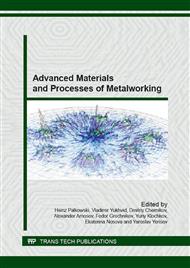[1]
I.N. Vladimirov, M.P. Pietryga, S Reese, On the influence of kinematic hardening on plastic anisotropy in the context of finite strain plasticity, From the issue entitled Material models for sheet metal forming, International Journal of Material Forming. Vol. 4. 2 (2011).
DOI: 10.1007/s12289-011-1038-7
Google Scholar
[2]
A. Baltov, A. Savchuk, A Rule of Anisotropic Hardening, Acta Mechanica. Vol. 1. 2 (1965) 81 - 92.
DOI: 10.1007/bf01174305
Google Scholar
[3]
W. Oiszak, W Urbanovski, The Generalised Distortion Energy in the Theory of Anisotropic Bodies, Bull. Acad. Polon. Sci. Vol. 5. 1 (1957) 29 - 45.
Google Scholar
[4]
G. Rousselier, F. Barlat, J.W. Yoon, A novel approach for modeling of anisotropic hardening and non proportional loading paths, application to finite element analysis of deep drawing, From the issue entitled Proceedings of the 12th ESAFORM Conference on Material Forming, International Journal of Material Forming. 1 (2009).
DOI: 10.1007/s12289-009-0423-y
Google Scholar
[5]
J.W. Yoon, R.E. Dick, F. Barlat, Analytical Approach to Predict Anisotropic Material Properties from Cup Drawings, From the issue entitled Proceedings of the 11th ESAFORM Conference on Material Forming,; International Journal of Material Forming. Vol. 1. 1 (2008).
DOI: 10.1007/s12289-008-0344-1
Google Scholar
[6]
F.V. Grechnikov, The deformation of anisotropic materials, Mashinostroenie, Moscow, (1998).
Google Scholar
[7]
Y.M. Aryshensky, The theory of sheet metal forming of anisotropic materials, Saratov University Publishing, (1973).
Google Scholar
[8]
Y.M. Aryshensky, F.V. Grechnikov, V.Y. Aryshensky, Achieving rational anisotropy in sheets, Metallurgy, Moscow, (1987).
Google Scholar
[9]
E.A. Popov, V.G. Kovalev, I.N. Shubin, Technology and automation of sheet metal forming, BMSTU, Moscow, (2000).
Google Scholar
[10]
E.A. Popov, Basics of sheet metal forming theory, Mashinostroenie, Moscow, (1977).
Google Scholar
[11]
M.V. Storozhev, E.A. Popov, Theory of pressure working of metals, Mashinostroenie, Moscow, (1971).
Google Scholar
[12]
A.M. Dmitriev, A.L. Vorontsov, Approximation of hardening curves of metals, Forging and Stamping Production. Material Working by Pressure 1 (2004) 23-26.
Google Scholar
[13]
A.M. Dmitriev, A.L. Vorontsov, The technology of forging and die stamping. Part 1. Extrusion forming, Vysshaya Shkola, Moscow, (2002).
Google Scholar
[14]
Z. Marciniak, K. Kuczyński. Limit strains in the processes of stretchforming sheet metal, International Journal of Mechanical Sciences. Vol. 9. 9 (1967) 609–620.
DOI: 10.1016/0020-7403(67)90066-5
Google Scholar
[15]
Y. Yamada, M. Koide. Analysis of the Bore-Expanding Test by the Incremental Theory of Plasticity, Int. J. Mech. Sci. Vol. 10 (1968) 1 - 14.
Google Scholar
[16]
E.G. Demyanenko, I.P. Popov, A.G. Shlyapugin, The study of the process of forming integral pressed parts according to the flanging-forming scheme, Vestnik SSAU 1 (2006) 138-145.
Google Scholar
[17]
I.P. Popov, V.D. Maslov, Directional change of thickness of the workpiece in sheet metal forming operations, Forging and Stamping Production. Material Working by Pressure 6 (1999) 19–21.
Google Scholar


